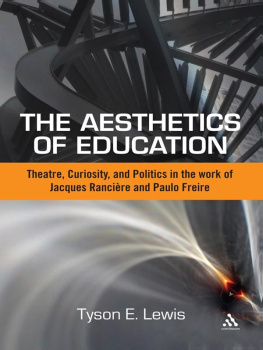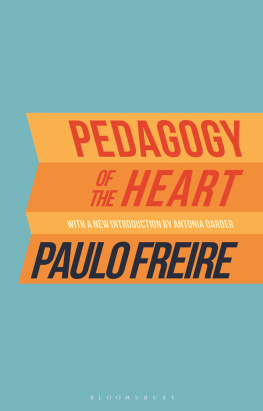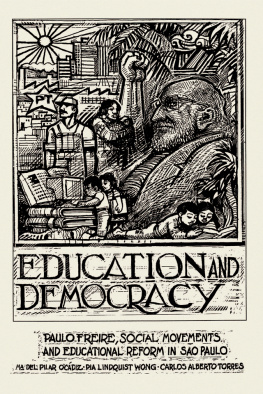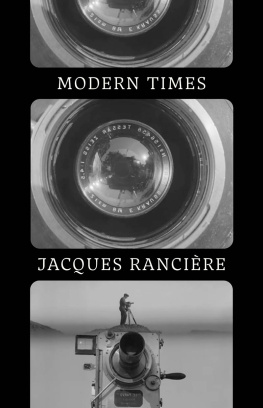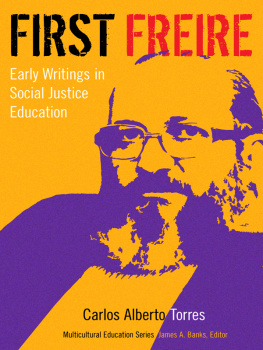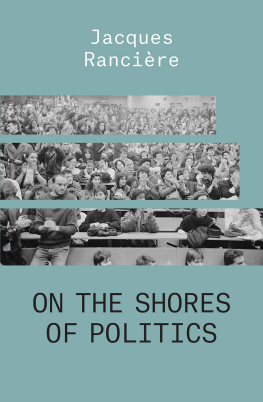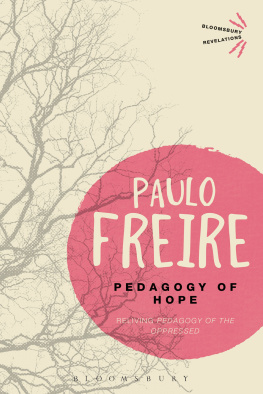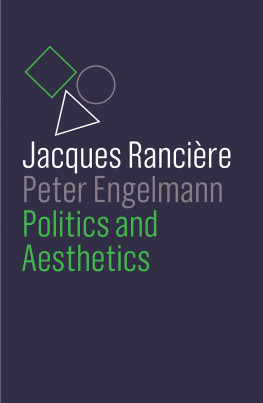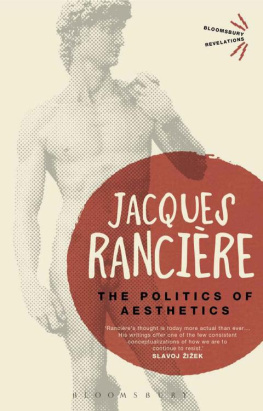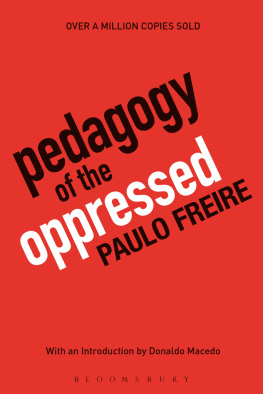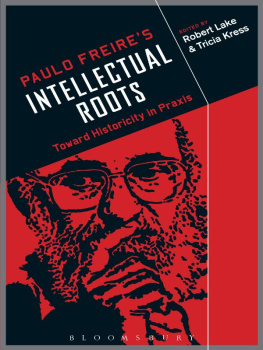
The Aesthetics of Education:
Theatre, Curiosity, and Politics in the Work of Jacques Rancire and Paulo Freire
Tyson E. Lewis

Continuum International Publishing Group
A Bloomsbury company
80 Maiden Lane, New York, NY 10038
50 Bedford Square, London, WC1B 3DP
www.continuumbooks.com
Tyson E. Lewis 2012
All rights reserved. No part of this book may be reproduced, stored in a retrieval system, or transmitted, in any form or by any means, electronic, mechanical, photocopying, recording, or otherwise, without the permission of the publishers.
ISBN: 9781441163738
Library of Congress Cataloging-in-Publication Data
A catalog record for this book is available from the Library of Congress.
Typeset by Fakenham Prepress Solutions, Fakenham, Norfolk NR21 8NN
Contents
Introduction:
The Aesthetics of Education
Chapter One:
From Stultification to Emancipation: Althusser avec Rancire
Chapter Two:
Aesthetic Forms: Teaching, Theatre, and Democracy
Chapter Three:
The Beautiful and the Sublime in the Pedagogy of the Oppressed
Intermission:
Equality, Freedom, and Emancipation: A Case for Pedagogical Dramaturgy
Chapter Four:
The Aesthetics of Curiosity
Chapter Five:
The Knowledge of Ignorance
Chapter Six:
The Future of the Image in Critical Pedagogy
Chapter Seven:
Freires Last Laugh
Conclusion:
Death and Democracy in Education: Freires Easter Revisited
There are many people I would like to thank for their assistance with this book. First and foremost, I would like to acknowledge Gert Biesta who has supported my project from the beginning and has given me generous feedback on several chapters of this book which appeared as separate articles in his journal Studies in Philosophy and Education. Also, my Belgian colleagues, Jan Masschelein, Maarten Simons and Joris Vlieghe have been instrumental in providing insight into many of the ideas presented in the following pages, and their imprint on this manuscript cannot be underestimated. It is also important to recognize Eduardo Duarte, Daniel Friedrich, Megan Laverty, Rene Arcilla, David Backer, and Mike Schapira who all participated in a Rancire reading group at Teachers College. In particular, Megan inspired me to take a closer look at the Kantian dimensions of Rancires writings, Eduardo provided persistent skepticism of several of the claims that formed the backdrop of my project, Daniel remained a constant source of insight into Rancires work, and Rene provided me with a set of challenges which I hope to have met. Finally, my graduate assistant, Olivier Michaud, helped me track down obscure references and provided help with the translation of several French sources.
This acknowledgement would be incomplete if I did not recognize my wife, Anne Keefe, and her infallible editorial advice and her keen eye for the turn of a phrase and the power of a metaphor for unlocking the poetics of my own writing. But most importantly, I would like to end with an acknowledgement that is also a dedication. Before reading Rancires book I had already been introduced to its basic thesis. In fact, the book seemed to be a shockingly simple and elegant affirmation of something that my father, Steven Lewis, had taught when I was a young child: that nights are not for sleeping but for dreaming, creating, and thinking. As a man with only a high-school education, my father refused any predetermined role as a mere laborer whose nights should be spent sleeping in order to replenish his labor-power for the following day. Instead, he spent his nights singing in bands, writing songs, and teaching himself various instruments. With little formal education, he denied the predictions of cultural habitus and took up reading novels, critical theory, and political analyses. Indeed, my father is one of those unlikely individuals who has consistently challenged the divisions of labor that scar our society: divisions between the hand and the mind, the night and the day, the literate and the illiterate. As such, the pages of this book are infused with the spirit of my father. Thanks, Dad.
The development of mans capacity for feeling is, therefore, the more urgent need of our age, not merely because it can be a means of making better insights effective for living, but precisely because it provides the impulse for bettering our insights.
Fredrich Schiller, On the Aesthetic Education of Man
In the novel The City and the Cityxs by China Mieville (2010), the reader follows the Kafkaesque journey of Inspector Tyador Borlu through the labyrinthian political conspiracy set in two politically autonomous yet territorially overlapping cities: Beszel and Ul Qoma. Although grosstopically interwoven like topographic doppelgangers, the two cities are perceived as distinct political and cultural territories. Even as citizens from the two cities intermingle on divided streets, live in buildings where different floors exist in different cities, and children climb on trees territorially split (crosshatched) down the center, they must learn to unsee and unnotice one another. The major role of education is to teach children the peculiar skill of literally unseeing what one is seeinga paradoxical gesture which demands both seeing and not seeing simultaneously. For instance, Ul Qoman drivers must avoid collisions with oncoming Beszel traffic all the while unseeing the cars they must avoid. Looking out the window of Senior Detective Qussim Dhatts house, Ul Qoman detective Borlu summarizes this startling situation:
From their living room I saw that Dhatt and Yallyas [Dhatts wife] rooms and my own overlooked the same stretch of green ground, that in Beszel was Majdlyna Green and in Ul Qoma was Kwaidso Park, a finely balanced crosshatch. I had walked in Majdlyna myself often. There are parts where even individual trees are crosshatched, where Ul Qoman children and Besz children clamber past each other, each obeying their parents whispered strictures to unsee the other.
(Mieville 2010, 195)
To move from one city to the other is an experience of unseeing what one is unseeingnot so much a physical journey as a perceptual shift. As Tyador Borlu experiences when traveling between cities, the re-education process is a painful redistribution of what can and cannot be seen, what can and cannot be heard, what can and cannot be acknowledged. When his investigation into the murder of a young graduate student takes him from Beszel to Ul Qoma, he literally must train his eye to perceive what years of habituation had taught him to ignore. Borlu narrates, Mostly, as with our own equivalents, the course [an orientation to life in Ul Qoma] was concerned to help a Besz citizen through the potentially traumatic fact of actually being in Ul Qoma, unseeing all their familiar environs, where we lived the rest of our life, and seeing the buildings beside us that we had spent decades making sure not to notice (Mieville 2010, 133). This acclimation pedagogy uses complex computer simulations to work directly on the field of perception. Again, Borlu describes the acclimation apparatus: They sat me in what they called an Ul Qoma simulator on which they projected images and videos of Beszel with the Besz buildings highlighted and their Ul Qoman neighbours minimized with lighting and focus. Over long seconds, again and again, they would reverse the visual stress, so that for the same vista Beszel would recede and Ul Qoma shine (Mieville 2010, 133). Here education is an education in and of perceptual alterationa learning to see, hear, smell, taste differently.
Next page
